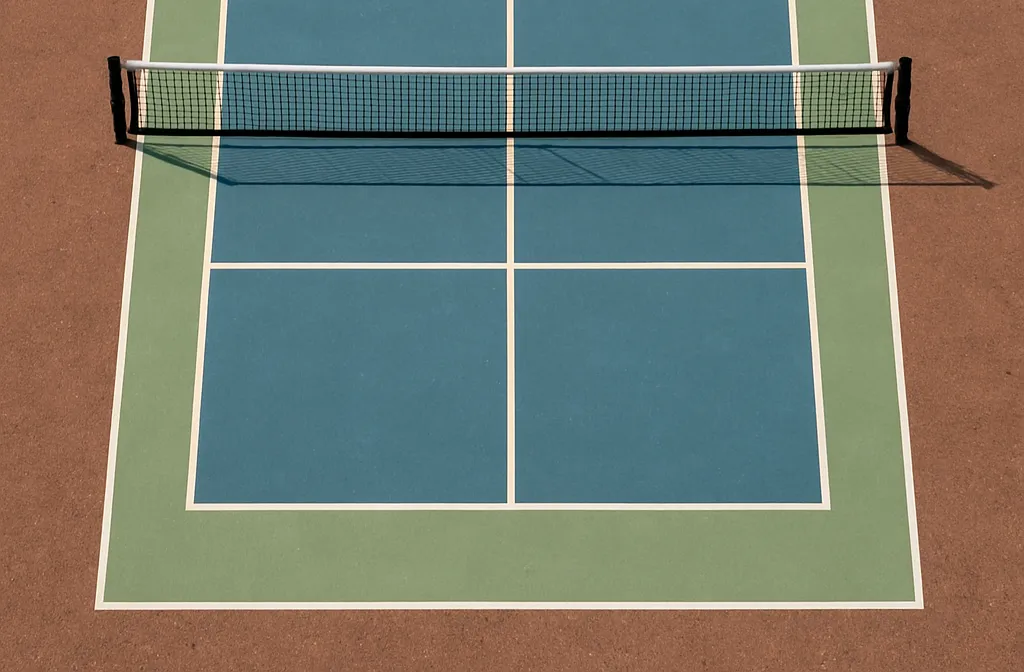
How Big Is The Kitchen in Pickleball
Pickleball, a fast-paced paddle sport combining elements of tennis, badminton, and table tennis, has been gaining popularity worldwide. Its appeal lies in its accessibility to players of all ages and skill levels, as well as the strategic depth it offers. Whether you're new to the game or a seasoned player, understanding the dimensions of the court, especially the "kitchen," is crucial. The kitchen, also known as the non-volley zone, plays a pivotal role in the game's strategy and rules, influencing the style of play and determining how points are won or lost.

Before diving into the specifics of the kitchen's size, it's essential to understand what the kitchen is. The kitchen in pickleball is the area on the pickleball court coating where volleys are restricted. This means players cannot hit the ball in the air while standing in this zone. The kitchen is designed to prevent players from executing smashes directly at the net, thereby promoting longer rallies and more strategic play. By limiting aggressive net play, the kitchen encourages players to focus on finesse and precision.
The kitchen also serves as a tactical element that can make or break a match. Players must develop the ability to navigate this zone efficiently, using it to set up points and keep opponents on the defensive. Its presence requires competitors to continually adjust their positioning and shot selection, adding layers of complexity to what might seem at first to be a simple game.
Pickleball Kitchen Dimensions
How Deep is the Kitchen in Pickleball?
The kitchen in pickleball is precisely 7 feet deep. This measurement extends from the net towards the baseline on both sides of the court. The depth of the kitchen is consistent across all pickleball courts, whether they are indoor or outdoor. This uniformity ensures that players can apply their skills and strategies consistently, regardless of where they play.
Understanding the depth of the kitchen is essential for developing court awareness. Players must learn to gauge this space accurately to avoid faults and leverage it during play. The 7-foot depth requires quick reflexes and strategic positioning to handle dinks and drops effectively, making it a critical factor in a player's overall performance.
How Wide is the Kitchen?
The width of the kitchen spans the entire width of the court, which is 20 feet. Therefore, the kitchen forms a rectangle measuring 7 feet by 20 feet on each side of the net. This expansive width means that players need to be adept at covering ground quickly to respond to shots that land in this zone.
The kitchen's width also demands that players maintain a balance between aggression and caution. While it may be tempting to play aggressively, the kitchen's restrictions require players to exercise restraint and focus on strategic shot placement. Mastering this balance is key to maintaining control during rallies and executing successful plays.
Total Kitchen Area
To calculate the total area of the kitchen on one side of the court, multiply the length by the width:
[ \text{Area} = 7 \text{ feet (depth)} \times 20 \text{ feet (width)} = 140 \text{ square feet} ]
Since the kitchen is present on both sides of the net, the combined area is ( 2 \times 140 = 280 \text{ square feet} ).
This sizable area emphasizes the importance of understanding the kitchen's boundaries and dynamics. Players who can effectively navigate this space gain a significant advantage, as they can dictate the pace and flow of the game. The kitchen is not just a physical boundary but a tactical one, shaping the strategies and outcomes of matches.
Importance of the Kitchen in Pickleball
Strategic Play
The kitchen plays a crucial role in strategic play. Because players cannot volley in this zone, they must develop skills in dinking — a soft shot that lands in the opponent's kitchen, forcing them to hit upward. This tactic helps in setting up offensive plays and controlling the pace of the game. Dinking requires precision and timing, as well as an understanding of the opponent's positioning.
Beyond dinking, the kitchen forces players to engage in a mental game of chess, anticipating opponents' moves and planning several steps ahead. Mastery of kitchen play allows players to exploit weaknesses in their opponents' positioning and create opportunities for decisive shots, making it a cornerstone of advanced pickleball strategy.
Rule Enforcement
Understanding the kitchen dimensions is vital for rule enforcement. A common fault in pickleball is stepping into the kitchen when volleying. Knowing the exact boundaries helps players avoid this mistake, ensuring fair play. This knowledge is crucial during competitive matches, where even a small misstep can change the outcome of a game.
In addition to avoiding faults, players must also be aware of how their movement and positioning affect their ability to execute shots legally. The pickleball kitchen rules demand a high level of discipline and concentration, requiring players to constantly monitor their footing and adjust their strategies accordingly.
How to Use the Kitchen to Your Advantage
Mastering Dinks
Dinks are an essential skill in pickleball. Practice hitting the ball softly so it lands just over the net in your opponent's kitchen. This shot limits their options and can force an error, giving you an advantage. Dinks require a delicate touch and the ability to read your opponent's movements, making them a valuable tool in any player's arsenal.
To master dinks, players should focus on developing consistency and control, practicing different angles and spins to keep opponents guessing. The ability to execute a well-placed dink can turn the tide of a rally, putting pressure on opponents and setting up opportunities for more aggressive shots.
Positioning

Good positioning is key to effective kitchen play. Stay just behind the kitchen line, ready to step in and hit a dink or retreat to hit a deeper shot. This stance allows for quick movements and adaptability during rallies. Being well-positioned enables players to maintain a strong defensive posture while also being prepared to transition to offense when the opportunity arises.
Positioning also involves anticipating the opponent's shots and adjusting your stance accordingly. By maintaining a dynamic and responsive position, players can enhance their ability to respond to a variety of shots, whether they're aimed at the kitchen or the baseline.
Common Misconceptions About the Kitchen
The Kitchen is Only for Beginners
Some believe the kitchen is only a concern for beginners. However, even seasoned players must respect this zone's rules. Mastery of kitchen play is often what separates intermediate players from advanced ones. The kitchen's strategic nuances offer endless opportunities for improvement, regardless of skill level.
Advanced players understand that the kitchen is not just a physical barrier but a critical component of high-level strategy. By refining their skills in this area, players can enhance their overall game, gaining a tactical edge that can be the difference between victory and defeat.
You Can Volley from Behind the Kitchen Line
Players sometimes mistakenly think they can volley as long as they start behind the kitchen line. However, if momentum carries them into the kitchen after the volley, it is still a fault. Always ensure you're outside the kitchen when making contact with the ball during a volley. This rule emphasizes the importance of body control and awareness during play.
By understanding and respecting the kitchen rules, players can avoid unnecessary faults and maintain a clean, competitive game. Awareness of these regulations helps build a foundation for successful play and fosters a deeper appreciation for the sport's strategic complexity.
Tips for New Players
Practice Awareness
Spend time familiarizing yourself with the court dimensions. Walk the kitchen line and practice stopping just before it to develop spatial awareness during play. This exercise helps new players build confidence and improve their ability to navigate the court effectively.
Developing spatial awareness is crucial for executing precise shots and maintaining control during rallies. By regularly practicing court positioning, players can enhance their ability to anticipate their opponents' moves and react with agility and accuracy.
Watch the Pros
Observing professional pickleball matches can provide insights into effective kitchen play. Note how players position themselves and execute dinks under pressure. Watching skilled players in action can offer inspiration and highlight techniques that can be incorporated into your own game.
By studying professional matches, players can learn advanced strategies and gain a deeper understanding of the game's intricacies. Observing how top players handle the kitchen can provide valuable lessons in timing, positioning, and shot selection, helping players elevate their skills and performance.
Conclusion
The kitchen in pickleball, though a small area, has a significant impact on the game's dynamics. Understanding its dimensions and strategic importance can enhance your play, whether you're a novice or a seasoned competitor. By mastering the art of dinks and maintaining awareness of the kitchen's boundaries, you can gain a competitive edge in your matches.
The kitchen's strategic complexity and rule-based restrictions make it a unique and essential element of pickleball. By appreciating its role in shaping the flow of the game, players can unlock new levels of skill and enjoyment. So, next time you step onto the pickleball court, remember the importance of the kitchen and use this knowledge to elevate your game.
Happy playing!




